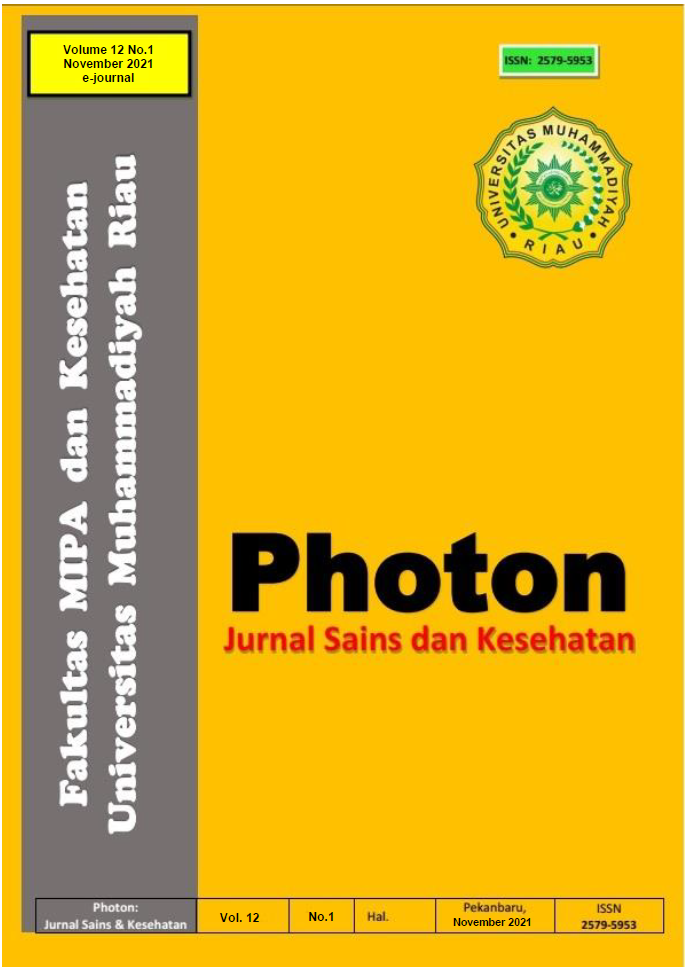Sintesis Biodiesel dari Minyak Jelantah Menggunakan Katalis Bentonit, K-Bentonit Dan K-Bentonit Terimpregnasi CaO
DOI:
 https://doi.org/10.37859/jp.v12i1.3312
https://doi.org/10.37859/jp.v12i1.3312
Abstract
Biodiesel is an alternative fuel for diesel engines produced by a transesterification reaction between vegetable oils or animal fats containing triglycerides and alcohol, one of which is methanol. The use of homogeneous base catalysts in the synthesis of biodiesel still poses a problem for the environment because it is difficult to separate, therefore, researchers use variations of heterogeneous base catalysts. The synthesis of biodiesel from used cooking oil was carried out through a transesterification reaction with technical methanol with a catalyst of CaO impregnated Bentonite, K-Bentonite and Bentonite using the reflux method at 65ºC for 2 hours. The ratio of the volume of oil, methanol, and catalyst used is 5:1:1%-w oil. Based on the research that has been done, the yield of each catalyst is 84.85% bentonite, 84.24% K-bentonite and 89.27% K-bentonite-CaO. The characteristics of biodiesel obtained from each of these catalysts such as calorific value and density have met the quality requirements of the Indonesian National Standard (SNI 7182-2012), except for the acid number and kinematic viscosity which still exceed the quality requirements of SNI 7182-2012.
Downloads
References
Badan Standardisasi Nasional. (1998). SNI 01-3555-1998. Cara uji minyak dan lemak.
Badan Standardisasi Nasional. (1998). SNI 7182-2012. Karakteristik kualitas Biodiesel.
Haryanto, A., Silviana, U., Triyono, S., & Prabawa, S. (2015). Produksi biodiesel dari transesterifikasi minyak jelantah dengan bantuan gelombang mikro: pengaruh intesitas daya dan waktu reaksi terhadap rendemen dan karakteristik biodiesel. Agritech, 35(2), 234–240.
Haryono, E., Dimas, R., Witjonarko, E., Teknik, J., Kapal, P., Perkapalan, P., & Surabaya, N. (2017). Analisa Unjuk Kerja Mesin Diesel Kapal Dua Langkah ( Two Stroke Marine Diesel Engine ) Berbahan Bakar Campuran Minyak Solar ( Hsd ) Dan Biodiesel Minyak Jelantah Pada Beban Simulator Full Load. Jurnal Inovtek Polbeng, 7(2).
Kartika, D., & Widyaningsih, S. (2012). Konsentrasi Katalis dan Suhu Optimum pada Reaksi Esterifikasi menggunakan Katalis Zeolit Alam Aktif ( ZAH ) dalam Pembuatan Biodiesel dari Minyak Jelantah. Jurnal Natur Indonesia, 14(3), 219–226.
Mahesh, S. E., Ramanathan, A., Begum, K. M. M. S., & Narayanan, A. (2015). Biodiesel production from waste cooking oil using KBr impregnated CaO as catalyst. Energy Conversion and Management, 91, 442–450.
Mahreni, & Setyoningrum, T. M. (2010). Produksi Biodisel dari Minyak Jelantah Menggunakan Katalis Asam padat ( Nafion / SiO 2 ). Jurnal Eksergi, X, 52–57.
Mawarni, D. I., Tinggi, S., Ronggolawe, T., Suryanto, H., Tinggi, S., & Ronggolawe, T. (2018). pengaruh suhu pengadukan terhadap yield biodiesel dari. Jurnal SIMETRIS, 9(1), 49–54.
Nurfadillah. (2011). Pemanfaatan dan uji kualitas biodiesel dari minyak jelantah. Skripsi.Program Studi Kimia fakultas Sains da Teknologi: Universitas Islam Negeri Alauddin.
Prasetya, Yuhelson, Fauzi, M. ., & Triasih, P. (2016). Penggunaan lempung bentonit sebagai katalis heterogen yang ramah lingkungan dibandingkan katalis homogen untuk produksi biodiesel dari minyak sawit bekas penggorengan. Prosiding Seminar nasional “Pelestarian Lngkungan Dan Mitigasi Bencana,” 11–16.
Siswani, E. D., Kristianingrum, S., & Suwardi. (2012). Sintesis dan karakterisasi biodiesel dari minyak jelantah pada berbagai waktu dan suhu. Prosiding Seminar Nasional Penelitian, Pendidikan Dan Penerapan, 103–112.
Sukmana, N. C., & S, E. P. (2011). Kalor Biodiesel Hasil Esterifikasi Dengan Katalis Asam Sitrat Dan Transesterifikasi Dengan Katalis Kalium Hidroksida Minyak Biji Nyamplung (Calophyllum inophyllum). Prosiding Tugas Akhir Semester Genap, 1.
Tamilselvan, P., Nallusamy, N., & Rajkumar, S. (2017). A comprehensive review on performance, combustion and emission characteristics of biodiesel fuelled diesel engines. Renewable and Sustainable Energy Reviews, 79(April), 1134–1159.
Uprety, B. K., Chaiwong, W., Ewelike, C., & Rakshit, S. K. (2016). Biodiesel production using heterogeneous catalysts including wood ash and the importance of enhancing byproduct glycerol purity. Energy Conversion and Management, 115, 191–199.
Downloads
Published
How to Cite
Issue
Section
License
Each article is copyrighted © by its author(s) and is published under license from the author(s).
When a paper is accepted for publication, authors will be requested to agree with the Creative Commons Attribution-Noncommercial-No Derivative Works 4.0










